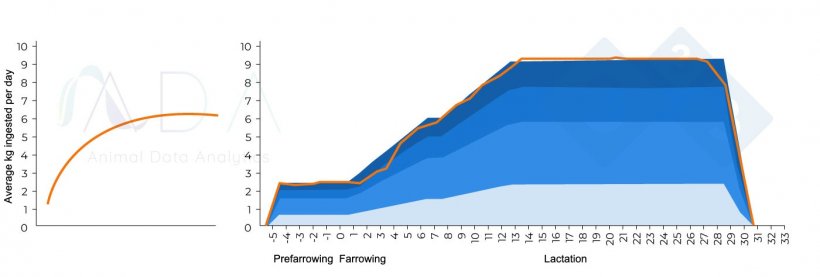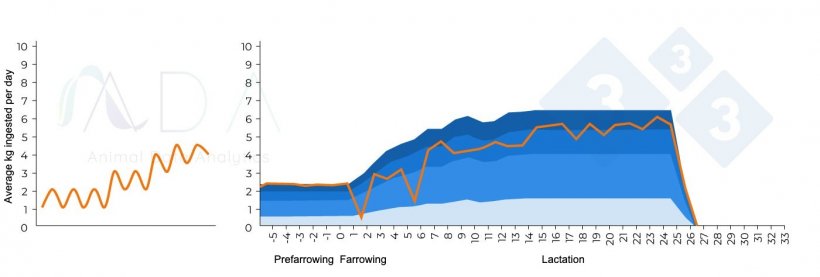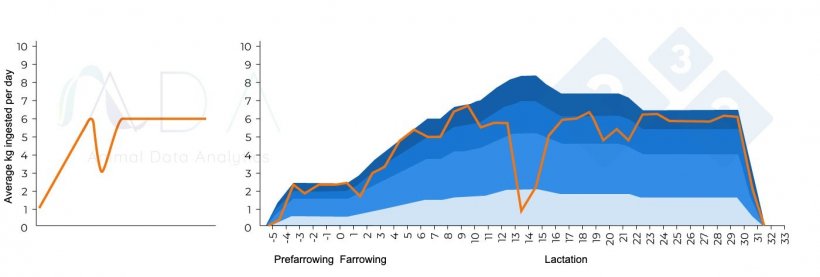We started the previous article by pointing out the exceptional performance that modern sows can deliver in lactation when their needs are met and health status is good. According to INRA data in 2017, litter growth ranges between 2.5 and 3.0 kg per day, a figure that can reach up to 3.5 kg per day according to some personal comments received recently from Argentine producers. The metabolic effort for the lactating sow is extraordinary, since it involves generating 3 times the daily growth of a finishing pig. All this leads to producing litters weighing over 100 kg at weaning, depending on the weaning age, and generating a third of the sow's body weight in approximately 25 days.
This effort is not without cost and is influenced by several high-impact variables that can significantly reduce its potential, as demonstrated in commercial farms. In addition, this effort affects the sow's performance not only in the current parity but also for the rest of her productive life, which can be significantly shortened.

While the significant impact of health on performance is widely recognized and is outside the scope of this article, we will review, based on current data, the quantitative impact of some of the other most relevant factors affecting sows in this phase. Two studies with a common author (Koketsu, Y.) looked at the impact of total intake and associated patterns (Koketsu, 1996, Rodriguez, 2023). Interestingly, although they are 27 years apart, they reach very similar conclusions with some very valuable "evolutionary" differences in the development of sow behavior in this period.
Both studies focus on lactating sows' feed consumption patterns and use machine learning techniques to classify feed consumption patterns, finding that they are related to reproductive performance. One of the most interesting points and where both studies agree very precisely is that only 55% of sows follow a theoretically expected optimal pattern (the one usually suggested by genetic companies), as shown in Figure 1 (the y-axis shows the average kg ingested per day; the x-axis shows the pre-farrowing/lactation day).

Figure 1. Theoretical optimal feed intake pattern of the lactating sow and results in practice.
In other words, almost half of the sows need specific attention during lactation as they tend to deviate from the ideal intake, particularly young sows. Until now, detecting these deviations was impossible in practice, as feed was simply fed to the sows (usually 2-3 times a day and without regular collection of the leftovers). The authors further describe the five other intake patterns associated with different degrees of risk on the productive performances of the sow and piglets (Figure 2).
Some of the altered intake patterns of the lactating sow can be seen in practical terms below:

Figure 2. Theoretical altered pattern associated with postpartum mastitis and results in practice.

Figure 3. Theoretical altered pattern associated with a reaction to vaccination and results in practice.
What are the influential factors associated with lactating sows' feed intake? According to a multiple regression model used in our database, they are:
- Partity: Lower-parity sows consume less feed and are at greater risk of a drop in feed intake. This effect is frequently observed in primiparous sows, whose feeding management is particularly demanding. Remember that according to INRA data, the intake of first parity sows only covers 70% of their needs in the best case because the animal is still growing, compared to 80% in multiparous sows.
- Piglet weaning weight: The higher the intake, the higher the piglet weaning weight.
- The temperature of the farrowing room: A high average temperature is associated with lower intake.
- Farm effect: There are significant differences in intake between farms, suggesting a strong farm management and health component.
In addition to this, the second study, using a PAM (partition around medoids) grouping algorithm, evaluates the impact of the drop in intake of lactating sows and points out that low intake during all or part of lactation, and in particular in the first week, is frequently associated with a lower farrowing rate in the following parity, higher preweaning mortality, and a longer wean-to-mating interval. This is consistent with the description by some authors that feeding below the required levels may affect follicle growth and maturation, particularly in the pre-ovulatory and differentiation phases (Koketsu, 1996).
Some farrowing room feeding systems offer real-time monitoring of intake and can react quickly and effectively to these deviations (Figure 3).
Figure 3. Daily intake and its distribution.
| Kg received | % distribution | 1 | 2 | 3 | 4 | 5 | 6 | Daily average |
|---|---|---|---|---|---|---|---|---|
| 5.9 | 98.6 | |||||||
| 6.7 | 99.0 | |||||||
| 6.7 | 99.2 | |||||||
| 3.5 | 99.6 | |||||||
| 5.1 | 99.8 | |||||||
| 7.5 | 100 | |||||||
| 4.5 | 100 | |||||||
| 3.9 | 100.3 | |||||||
| 6 | 100.3 | |||||||
| 2.6 | 100.6 | |||||||
| 2.3 | 101 | |||||||
| 4.6 | 101.2 | |||||||
| 7.1 | 101.6 |
The blue colors indicate the percentage ingested compared to the expected in each of the six feeding windows of the day. The right column indicates the average for the day.
| > 100 % | 100-75 % | 75-50 % | 50-25 % | 25-0 % |
Modern systems provide quality information in the farrowing room itself, alerting to deviations in real-time. Image 1 shows an example screen with stall 1302 occupied by sow 663, with a winter multiparous curve with 28 days of lactation who, at the second feeding of the day at 9 h 53 min, has already eaten 4.064 kg, which is 119.95 % of the expected intake so far.


Image 1. Screen of a modern monitoring system providing high-quality information in lactation to the farrowing room worker.
This article highlights the importance of identifying and managing risk factors affecting feed intake during lactation and reacting quickly to any deviations from this to improve the reproductive performance of sows both in their current parity and in subsequent ones.



